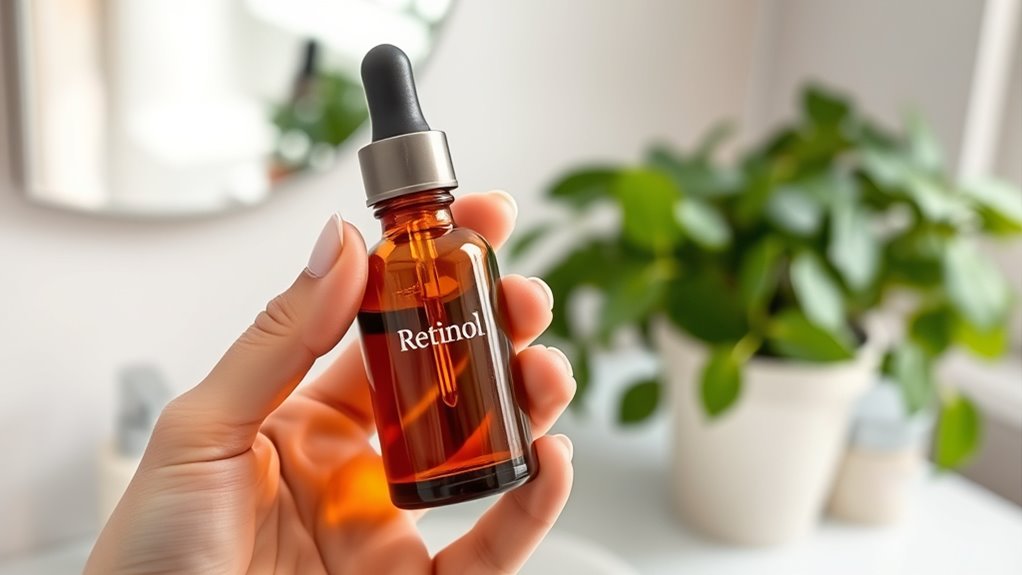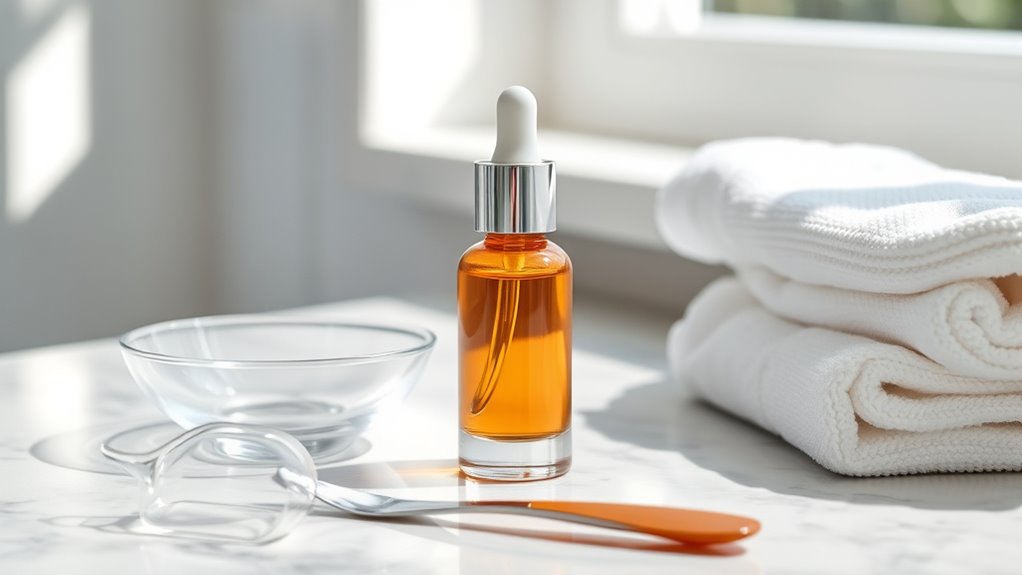When starting retinol, begin with low concentrations like 0.25% or 0.5% and apply it only at night on dry, clean skin. Use a pea-sized amount and wait a few minutes before moisturizing. Avoid overdoing it and skip harsh products to prevent irritation. Always use broad-spectrum SPF daily to protect your skin. Want to learn more about building a safe and effective retinol routine? Keep exploring for helpful tips.
Key Takeaways
- Start with low concentrations (0.25% or 0.5%) and apply only at night to minimize irritation.
- Conduct a patch test before initial use and gradually increase frequency as your skin builds tolerance.
- Always use a broad-spectrum SPF daily and avoid over-exfoliating to protect your skin from UV damage and irritation.
- Apply retinol on dry skin, use moisturizer afterward, and avoid the delicate eye area during application.
- Be patient; consistent nightly use and proper skincare habits are essential for safe, effective results.
How to Start Using Retinol Safely

Starting retinol can be exciting, but it’s important to introduce it carefully to avoid irritation. Begin with a low retinol concentration, such as 0.25% or 0.5%, to let your skin adjust gradually. Always apply retinol at nighttime, as it can increase photosensitivity and cause irritation if exposed to sunlight. Before your first use, do a patch test to check for any adverse reactions. When applying, use a pea-sized amount and spread it evenly over clean, dry skin, avoiding the delicate eye area. Wait a few minutes to ensure absorption before applying moisturizer. Consistently using retinol at night helps maximize its benefits while minimizing potential side effects. Patience is key—start slow and build up your tolerance over time. Incorporating sun protection into your routine is also crucial to shield your skin from UV damage while using retinol.
Common Mistakes to Avoid When Using Retinol

One of the most common mistakes people make when using retinol is applying too much too soon. This can cause irritation, dryness, and unnecessary discomfort. Instead, start with a small amount and gradually increase as your skin adapts. Remember, hydration tips are essential; use a moisturizer to keep your skin barrier healthy and prevent dryness. Skipping sun protection is another mistake that can lead to increased sensitivity and damage. Always apply a broad-spectrum SPF daily, especially when using retinol, because your skin becomes more vulnerable to UV rays. Avoid over-exfoliating or combining retinol with harsh products. Patience is key—give your skin time to adjust, and you’ll see better results without the setbacks caused by common mistakes. Incorporating Glycolic Acid in your routine, if done carefully, can complement retinol’s benefits but should be introduced gradually to avoid irritation.
Frequently Asked Questions
Can Retinol Be Used With Other Skincare Ingredients?
Yes, you can use retinol with other skincare ingredients, but you should be cautious about combination skincare. Avoid mixing retinol with strong acids like AHAs or BHAs, as this can cause irritation due to ingredient interactions. Instead, layer retinol with hydrating ingredients like hyaluronic acid. Always patch test new combinations and introduce one ingredient at a time to minimize potential adverse reactions and maximize benefits.
How Long Does It Take to See Results With Retinol?
You might start noticing subtle changes in your skin after about 4 to 6 weeks, as retinol absorption encourages skin cell turnover. While some see early improvements in texture and brightness, more significant results like fading fine lines may take up to 12 weeks. Patience is key, because consistent use helps your skin fully adapt to retinol’s gentle power, revealing a healthier, more radiant complexion over time.
Is Retinol Suitable for Sensitive Skin Types?
If you have sensitive skin, retinol can still work, but you need to be cautious. Start with a lower concentration and apply it sparingly to avoid irritation. Watch out for ingredient interactions, like combining retinol with harsh products, which can worsen sensitivity. Always do a patch test first, and consider consulting a dermatologist to tailor your skincare routine. With proper care, retinol can be suitable for sensitive skin types.
Can Pregnant Women Use Retinol Safely?
Pregnant women should avoid retinol due to pregnancy safety concerns, as high doses can harm your baby’s development. It’s best to consult your healthcare provider before using any retinol products. Follow retinol precautions carefully, like stopping use during pregnancy and breastfeeding. Opt for safer alternatives, such as gentle moisturizers or products containing bakuchiol, which offer skin benefits without risking your pregnancy. Always prioritize your health and your baby’s safety.
What Should I Do if I Experience Irritation?
If you experience irritation, like redness or dryness, stop using retinol temporarily. For example, Sarah noticed her skin became inflamed after a week, so she paused and focused on soothing remedies like aloe vera and gentle moisturizers. This helps protect your skin barrier and reduces discomfort. Keep your routine simple, avoid harsh products, and give your skin time to recover before gradually reintroducing retinol.
Conclusion
Starting retinol can transform your skin, but it’s important to do it right. Remember, over 80% of users see noticeable improvements within three months when they stick to a proper routine. By avoiding common mistakes and following safety tips, you’ll minimize irritation and maximize results. Stay patient and consistent—you’re investing in healthier, glowing skin. With the right approach, retinol can become your skincare secret for a radiant complexion.









